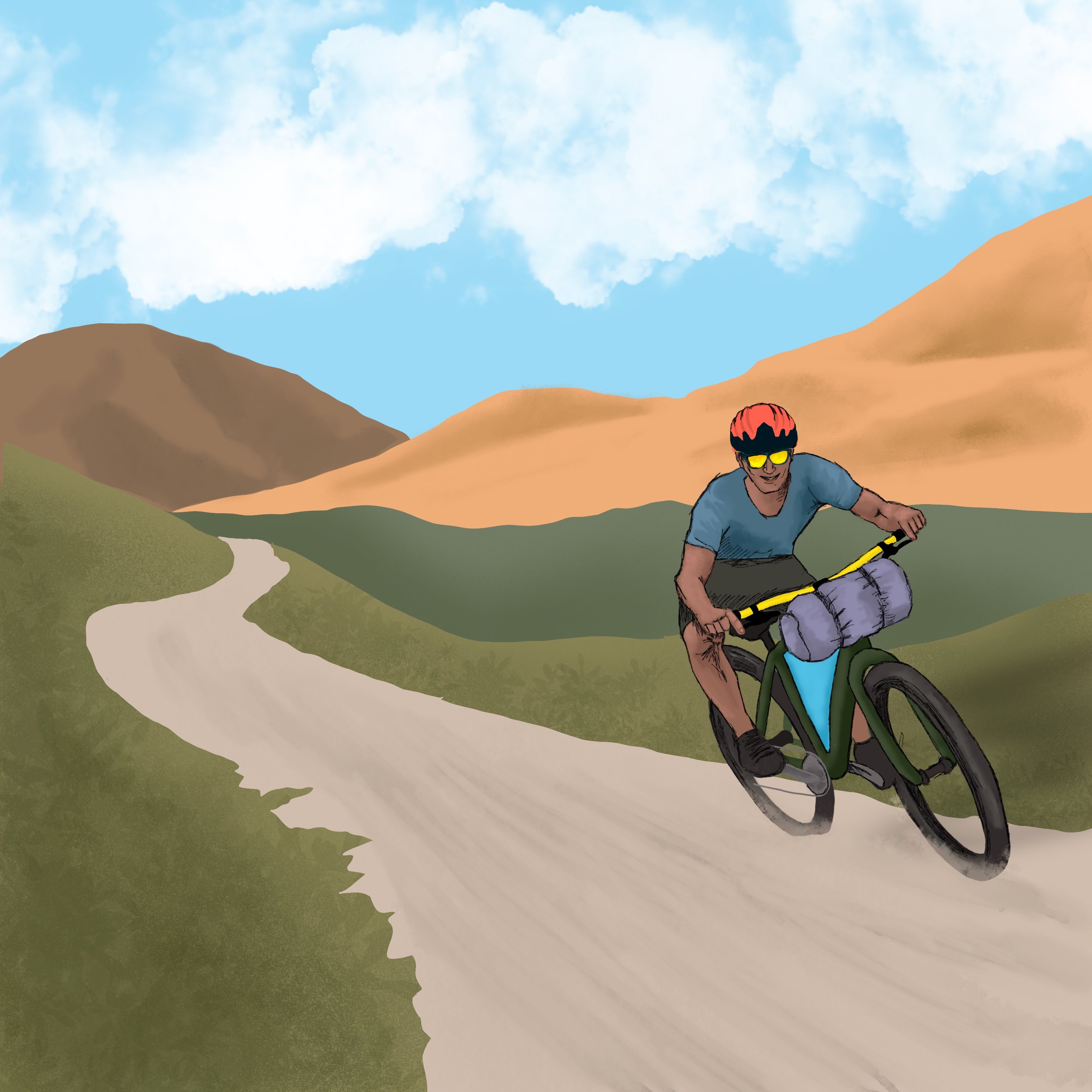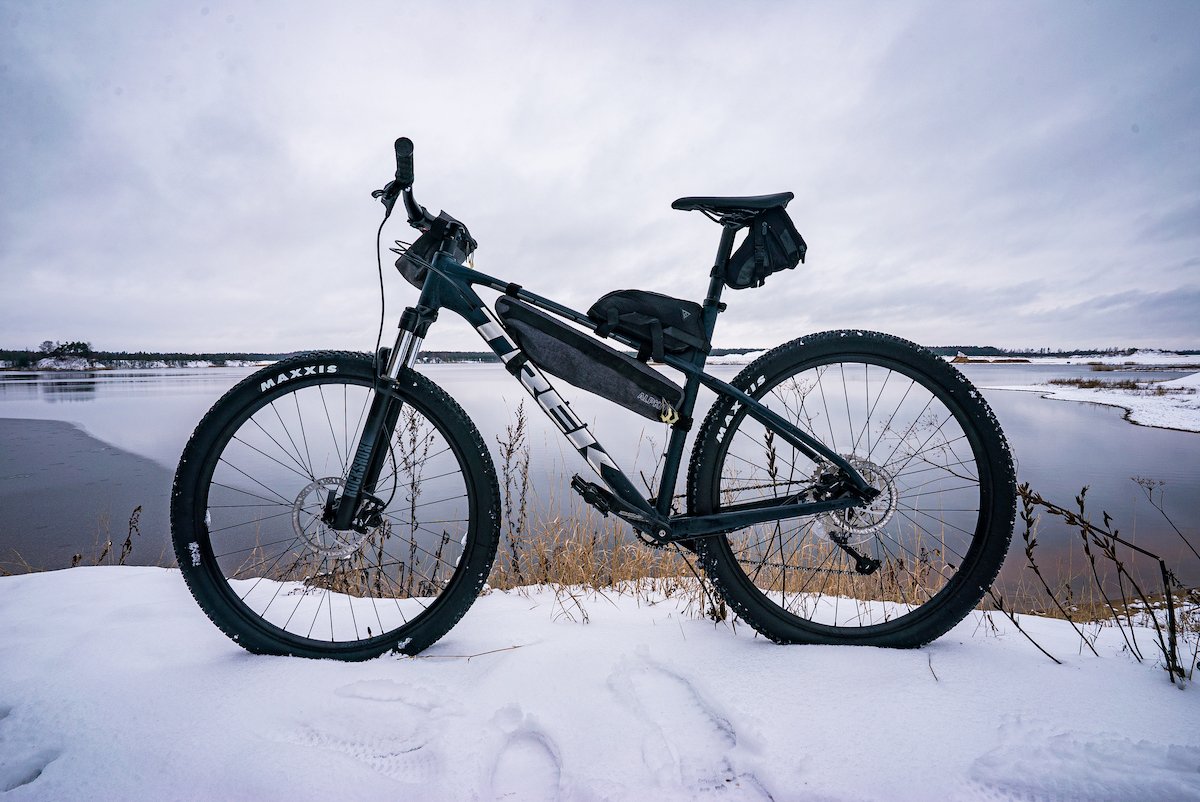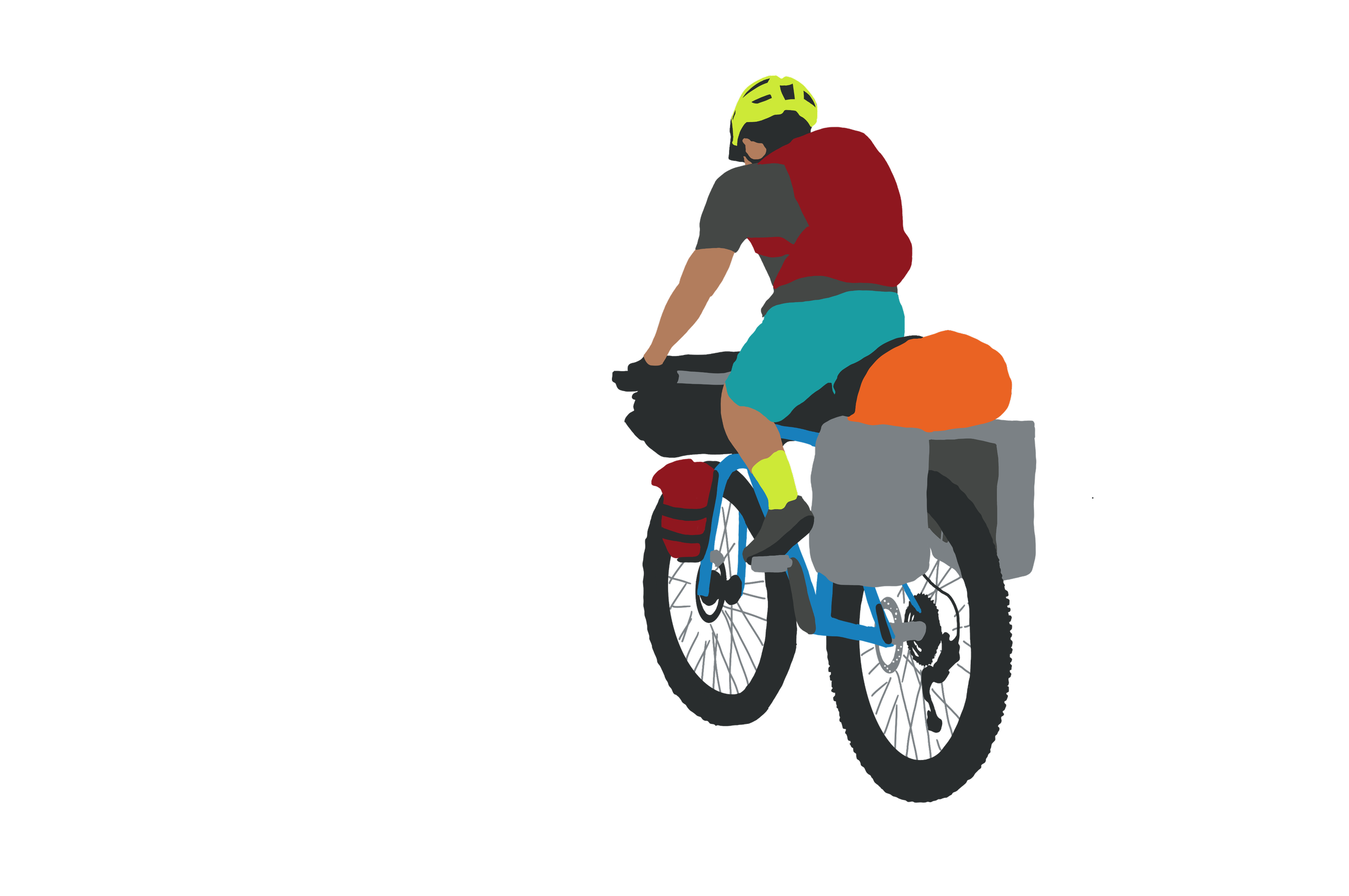
Bikepacking starter kit list:
36 things to consider taking on your first overnight trip
With cycle touring enjoying something of a renaissance in the form of ‘bikepacking’, with its lighter, smaller kit and aversion to pannier racks – it’s the perfect sports for us millennials that are fast approaching a more responsible era of our lives.
Ethics statement: Within the article, there are affiliate links. I’m not under any obligation to write anything about these products, nor was I provided with any sort of compensation to do so. If you buy something after clicking the link, I’ll receive a small commission. To know more about the terms of service, you can visit the link at the bottom of the page. Thank you!
1. A gravel, touring or mountain bike
This will be down to personal choice over whether you’ll mainly cycle on or off road, and whether the off road will be up mountains or just on gravel tracks. I found the Giant ToughRoad to be a useful do-it-all bike that has tyre clearance for putting bigger wheels on or keeping the gravel / touring set up for mainly road riding. You can read my review of the Trek Marlin 7 mountain bike I bought in 2022 to see what to look for in more detail.
2. A saddlebag
We bought some first-generation bikepacking bags in 2018 (when we first became aware of the sport) however have seen newer model that keep the attachment points on the bike whilst the drybag storage compartment can be removed. Please note: We’ve not used one yet so can’t vouch for how good they are in use, but the concept appears sound.
3. FixPlus Straps for attaching things to the bike
We’ve been using Fixplus straps since we started bikepacking this year and swear by them! They come in many sizes and can be used to secure all kinds of items to the bike, or for holding heavy things together.
4. Fork bottle cage – Topeak Versacage
We’ve been using these fork cages for a good few months now and are really impressed with them. Unless your forks come with bottle bosses already attached (such as the surly ones), you’ll need to fit a pannier or some kind of carrier cage. These come with 3 of Topeak’s excellent mounts to attach to the frame or forks to hold the cage in place. To prevent much slippage, we covered the fork with some black tape to give it a more grippier surface to place the cage on.
As with the saddlebag, these are one the crucial carrying points to put sleeping bag, tent etc. We’ve not yet tried the removable dry bag version for the front either, but we’ll be looking to do so before tackling the Silk Road Mountain race.
6. Frame bag (from Ride and Get Lost)
We had a custom one made by the awesome team at ‘Ride and Get Lost’ who’re based in Poland (yet ship to most places) and helped immensely with the peculiar measurements of our hydro-formed bike frame. They build it in a range of great colours and we’re sure they can accommodate anything specific needs from it.
7. Topeak Toploader top tube frame bag
We use this top tube bag for carrying a waterproof jacket or snacks at the front or back end of the top tube (it seems to be easily reversible whichever end you choose to mount it).
8. USB plug for powering your electrical items and power bank at fuel stations
There may be times when you need an unscheduled charge (like if you leave you electrical items outside in the cold and find they’ve lost their charge!), take a USB adaptor and the correct leads to take advantage of any charging opportunities you inadvertently come across.
9. Handlebar-mounted bottle or snack bags
We keep 2 bags attached to the stem and handlebar for keeping snacks close to hand to eat on the move. They’re also useful for storing sunglasses in if the weather is changeable and generally most are big enough to keep a thin warm or windproof layer in.
10. Flask (for carrying hot drinks)
We like to keep an 800ml flask strapped to the downtube in the colder months for carrying tea or hot squash (a trick we learned from mountain training in the Royal Marines – as it has a relatively high sugar content, it can give very quick burst of energy and can be drank when it’s any temperature and be enjoyable (as opposed to cold tea which is pretty grim!))
11. Camping stove - MSR pocket rocket
We’re currently using an old battered titanium Jetboil, however thinking of upgrading the burner element to an MSR pocket rocket when it finally gives up the fight.
At just 73 grams, MSR’s pocket rocket stove seems insanely light and highly regarded for bikepacking when paired with a titanium mug.
12. Cylindrical Tupperware container (to eat meals from and store cooked or perishable food)
We’ve found that a cylindrical Tupperware container can be a really useful thing for a multitude of reasons, such as eating from, storing leftover cooked food for later and storing soft or perishable snacks for later on.
For the times when you’re eating dehydrated food and don’t want to get it all over your food. Pass this tip on your friends so as not to look like an adventure newbie!
We’ve not found anywhere to strap a folding mat yet so have been using our inflatable mat. Everyone seems to be making them these days, so choice isn’t an issue.
15. Sleeping bag
Clearly your sleeping bag will depend on the location and time of year you start cycling. The size of the sleeping bag will dictate whether you put it in the handlebar or saddle bag.
A bivvy bag will come in mega useful for those nights when you don’t need a tent or intend to use a simple tarp set up and don’t want to get your sleeping bag soaked if it rains. Ideally you’ll want a breathable one so as not to end up in a puddle of sweat in the warmer months.
17. Nalgene 1.5L wide-mouth water bottle
This sits on one side of the forks and carries 1.5 litres of water which will cook your evening meal, the next day’s breakfast and enough water for drinking at night. We’ve found it best to keep toping up our backpack water bladder and leave this alone to be used for the night phase of the trip.
18. Wild Country Zephyros Compact 2 lightweight Tent
At only 1.3kg, this tent is epically light and useful. We only really taken the waterproof outer layer and telescopic pole to use as a one-person bivvy of sorts. It’s a 1.5 person capacity and entry / exit points from both side, it’s really useful when camping space is at a premium.
If you’ve ever hiked in Scotland during ‘mozzie season’ you’ll understand the need for mosquito spray. Leave it behind at your peril when you come to setting the tent up!
20. Head net
If the spray isn’t enough to deter the little critters and you decide to leave the tent inner at home in summer (understandable when it’s super warm), consider taking a heat net so you don’t wake up looking like you’ve been eaten by hungry locusts.
21. Anker PowerCore 10000 power bank
This one packs a good few phone and bike light charges in on one single charge.
22. Aquapac Waterproof Phone case
I’ve had this one from when I rowed across the Atlantic some 4 years+ ago and it’s still going strong. Be sure to test it for holes though before relying on it if you’re relying on your phone whilst intending to cross rivers etc.
23. Rechargeable bike lights
Bike lights are a really personal choice; therefore we’ll leave the decision on what to get to you. We prefer rechargeable ones to save us having to buy and carry tons of batteries (hard to dispose of and bad for the environment).
This will depend on the bike you use and its cost, however be sure to take a minimum of a 3,4,5,6 and (maybe an) 8mm allen key along with flat and cross head screwdrivers to fix most issues at the road side. Most disc brakes require a Torx key (star shaped as compared to the hexagonal allen keys).
25. ‘Sealing slime’ for inner tubes
We prefer a trip without punctures so add sealant to our tubes (we don’t intend to go tubeless for bikepacking as we feel it’s easier to change an inner tube in the worst case scenario). Depending on what bike you go for, you might need a valve core remover for adding the slime into the tubes. It’s definitely worth consulting a bike shop or knowledgeable friends on this though.
26. Spare inner tubes
We take one spare tube and a puncture repair kit to repair our bad luck moments, but that’s only because train stations and cities are nearby. If you’re going highly remote, you may not want to rely on a single tube.
Stick these on the tube or tyre to prevent leakage. And remember to carefully check the tyre in case the offending object is still embedded in it, otherwise you’ll be repairing another puncture when you’re a few minutes down the road, annoyingly.
28. Tyre levers
Be sure not to leave home without these unless you’ve got grip strength of an Olympic climber as you’ll struggle to get gravel or road tyres off the rim to get to the inner tube. We’ve pierced many a tyre with a metal lever and also snapped plastic ones, so pick whichever you feel most comfortable using on the road side in the dark and rain (you know it’s most likely to happen in adverse circumstances!).
29. Mini pump
Some people preferred the small canisters of compressed air, we prefer a mini pump to get enough air pressure in the tube and get to a fuel station air pump personally.
30. Small backpack for carrying a water bladder
Whilst it is preferable not to wear a backpack whilst cycling, there are times when you’ll need to increase your water-carrying capability between stops. Pair a lightweight backpack with accessible front pockets (for snacks and essential items) with your favourite water bladder to have all bases covered. We’ve found a 3L bladded paired with a 1.5L bottle and 800ml flask gives us the best capacity in mainland Europe.
31. Dual-sided flat / clipless pedals
It’s optimal to ride clipped in for speed and efficiency, there are times (particularly in urban areas) where you’ll want not to be, to react quicker to unforeseen obstacles and get your foot out to stabilise yourself. We use a similar pair of these cheap ones that have worked well in all situations.
We use a gravel bike for our bikepacking adventures, which we’ve optimised for road sections by adding an affordable pair of aero bars to give another position. It takes a few tweaks before they feel comfortable, but they’re great to tuck in and drastically cut down some drag!
33. Helmet
It goes without saying, ride with a helmet. We prefer a MIPS-equipped mountain bike one with peak removed (for when we’re low down on the aero bars), however ride with what you prefer, just don’t forget it!
34. Stanley classic hip flask (for the finish line)
It’s always good to have a hip flask filled with your finest tipple to celebrate the finish, we like to keep it safe in the Stanley classic hip flask as it has taken a beating over the years yet is still going strong!
35. JBL tune 115BT wireless headphones
We bought these wireless headphones in mid-2022 headphones for using with all of our favourite adventure sports – such as bikepacking, trail running, and gym work however hate getting tangled up in our headphone cables. Read our full review here.
36. Vivobarefoot Ultra III aquatic adventure shoes
We got on really well with these aquatic shoes when we rowed across the Atlantic, so much so that they’re still going strong some 5 years later and they come out on bikepacking trips with us when we need to cross water obstacles and let our feet breathe from hours inside stiff SPD shoes. They’re well made, light, durable and comfy - and we wrote a whole article on them (read it here)!









